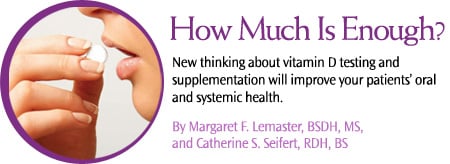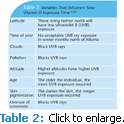
How Much Is Enough?
New thinking about vitamin D testing and supplementation will improve your patients’ oral and systemic health.
This course was published in the February 2011 issue and expires February 2014. The authors have no commercial conflicts of interest to disclose. This 2 credit hour self-study activity is electronically mediated.
EDUCATIONAL OBJECTIVES
After reading this course, the participant should be able to:
- Discuss the most effective method of measuring vitamin D levels in the body
- Identify recommendations for sun exposure levels necessary to produce vitamin D.
- Define the various recommendations for vitamin D supplementation.
Over the past decade, the importance of vitamin D and the negative implications of its deficiency have become well known. Often referred to as the “sunshine vitamin” because it is created via sun exposure, vitamin D was once associated only with bone health. Research now shows that vitamin D is related to cancer risk, pain, diabetes, and oral health, as well as osteoporosis.1-8 Dental hygienists are leaders in health education and should understand how vitamin D levels are measured, appropriate supplement guidelines, and any contraindications of supplementation.
MEASURING VITAMIN D
The 25(OH) vitamin D test is the best indicator of how much vitamin D is present in the body, however, it is difficult to clearly define specific values of sufficiency (click here for test information).9 Undoubtedly, serum 25(OH)D levels below 20 nanograms per milliliter (ng/ml) result in bone diseases, such as rickets in children and osteomalicia in adults.10 Insufficient serum 25(OH)D values of 30 ng/ml to 50 ng/ml are linked to “functional alterations” such as mild hyperparathyroidism, decreased bone mineral density, and low calcium absorption. Adequate levels of vitamin D expressed by serum levels of 25(OH)D remain controversial. The most widely agreed upon classifications of serum levels are listed in Table 1.11
SUN EXPOSURE RECOMMENDATIONS
Although sun exposure produces the most easily absorbed form of vitamin D,12 many individuals do not experience enough sun exposure to meet current daily recommendations.13,14 Vitamin D is produced only by ultraviolet B (UVB) and not ultraviolet A (UVA) rays. Dark-skinned individuals require up to five times more sun exposure to achieve the same result as lighter-skinned individuals.15,16 Lighter skinned individuals should avoid burning to prevent skin damage and reduce the risk of skin cancer. A 30-minute exposure to the summer sun during midday in a lighter-skinned individual will initiate the release of approximately 50,000 international units (IU) of vitamin D within 24 hours.17 As such, the current daily recommended intake of 400 IU a day may be far less adequate in providing normal circulating concentrations of vitamin D in adults with limited sun exposure than previously thought.
A broad recommendation for sun exposure is 10 to 15 minutes two times per week exposing, hands, face, arms, and back during peak summer sun. This exposure should release up to 20,000 IU of vitamin D into circulation.18 This intense but very brief sun exposure makes a significant difference in vitamin D levels.15,16,19 See Table 2 for a list of variables that influence solar vitamin D exposure.19, 20
SUPPLEMENTS
Unfortunately, vitamin D is present naturally in only a few foods and this type of vitamin D is not easily metabolized by the body. When adequate sun exposure is not an option, dietary supplements may be the best way to meet vitamin D recommendations. Vitamin D2 (ergocalciferol) and D3 (cholecalciferol) are both available as over-the-counter supplements. Vitamin D2 is synthesized by plants. Vitamin D3 is synthesized by exposure to UVB rays from sunlight.21 Vitamin D3 is thought to have the most beneficial systemic properties.
Vitamin D deficiency can be treated at a relatively low cost. On average, a 60-day supply of a vitamin D supplement ranges from $4 to $10.
Concrete recommendations for daily vitamin D intake are difficult to determine because vitamin D is stored in adipose tissue and its production is mostly endogenous. Individual vitamin D requirements are also dependent on age, gender, skin pigmentation, geographic location, and amount of sun exposure. There is also controversy about how much vitamin D is actually necessary for optimal health. There is no recommended daily allow ance (RDA) for vitamin D. Instead, the Institute of Medicine (IOM) in 1997 established a recommended intake level of international units (IU). These requirements reflect the skeletal needs for vitamin D, however, they do not take into consideration the needs of other tissues and physiologic systems.

Currently, there are varying government agency recommendations regarding the body’s minimum daily requirements for vitamin D (see Table 3). The Food and Drug Administration (FDA), US Department of Agriculture (USDA), and IOM all have different recommendations. Several published reports indicate that these recommendations are outdated and inadequate, particularly if there is no exposure to sunlight. A minimum of 1,000 IU of vitamin D is recommended for those with little or no sun exposure.22-24
Full-body sun exposure is equivalent to 50,000 IU of dietary vitamin D per day, yet daily requirements remain comparatively low. Several populations may benefit from increased daily recommendation of up to 5,000 IU, such as post-menopausal women, women of color, impoverished children, older adults, institutionalized/ bedridden adults, those with cancer, and those who are immunosuppressed, however, no recommendations have been officially established for these groups.
SERUM TESTING
Annual 25(OH)D serum level measurements with routine blood work are recommended to obtain baseline information. Independent laboratories that provide in-office testing are available, as are at-home tests.
MEDICATION INTERACTIONS WITH VITAMIN D
Several medications may react with vitamin D including glucocorticoids, heparin, methyltrexate, some anti-epileptic medications, and some antituberculosis medications. Dental professionals should advise patients about possible interactions when taking allupuronol, anticonvulsants, antacids, HIV antiretrovirals, antirejection medications, or estrogen and vitamin D supplements together (see Table 4).
PATIENT RECOMMENDATIONS
Dental professionals are in a unique situation to identify and refer patients with possible vitamin D deficiency to appropriate medical professionals. An optimal time to discuss vitamin D status and its role in total heath is chairside during a patient’s medical history review. Vitamin D supplementation is not recognized as a treatment for periodontitis. Even so, dental professionals should encourage patients to have their serum vitamin D levels evaluated by their primary care physicians in conjunction with conventional periodontal therapy, particularly if patients are at high risk of vitamin D deficiency. Current government standards for vitamin D intake may be substandard for optimal positive health outcomes. Public health guidelines need to be adjusted to include the beneficial aspects of vitamin D, as well as to recognize that the combination of dietary supplements and reasonable sun exposure maintains optimal serum 25(OH)D levels to promote health and prevent disease. Vitamin D is not a cure for chronic diseases, but evidence shows there may be beneficial outcomes related to adequate daily vitamin D intake.
REFERENCES
- Feskanich D, Fuchs CS, Kirkner GJ, Hankinson SE, Hollis BW, Giovannucci EL. Plasma vitamin D metabolites and risk of colorectal cancer in women. Cancer Epidemiol Biomarkers Prev. 2004;13:1502-1508.
- Garland C, Shekelle RB, Barrett-Connor E, Criqui MH, Rossof AH, Paul O. Dietary vitamin D and calcium and risk of colorectal cancer: a 19 year prospective study in men. Lancet. 1985;1:307-309.
- Thys-Jacobs S. Alleviation of migranes with therapeutic vitamin D and calcium. Headache. 1994;34:590-592.
- McKeigue P, Pierpoint, T, Ferrie, JE, MarmotMG. Relationship of glucose intolerance and hyperinsulinaemia to body fat pattern in south Asians and Europeans. Diabetologia. 1992;35: 785-791.
- Payne JB, Reinhardt RA, Nummikoski PV, Dunning DG, Patil KD. The association of cigarette smoking with alveolar bone loss in post menopausal females. J Clin Periodontol. 2000;27:658- 664.
- Payne JB, Reinhardt RA, Nummikoski PV, Patil KD. Longitudinal alveolar bone loss in postmenopausal osteoporotic/osteopenic women. Osteoporos Int. 1999;10:34-40
- Wactawski-Wende J, Grossi SG, Trevisan M, et al. The role of osteopenia in oral bone loss and periodontal disease. J Periodontol. 1996;67:1076-1084.
- Ruttimann UE, Webber RL, Hazelrig JB. Fractal dimension from radiographs of peridental alveolar bone: A possible diagnostic indicator of osteoporosis. Oral Surg Oral Med Oral Pathol. 1992;74: 98-110.
- 25-hydroxy vitamin D test. Available at:www.nlm.nih.gov/medlineplus/ency/article/003569.htm. Accessed January 20, 2011.
- Hewison M. Vitamin D and the immune system: new perspectives on an old theme. Endocrinol Metab Clin North Am. 2010;39:365-79.
- Holick MF. High prevalence of vitamin D inadequacy and implications for health. Mayo Clin Proc. 2006;81:353-357.
- Webb AK, Holick M. Influence of season and latitude on the cutaneous synthesis of vitamin D3: exposure to winter sunlight in Boston and Edmonton will not promote vitamon D3 synthesis in human skin. J Clin Endocrinol Metab. 1988;67:373-378.
- Lips P, Oleksik A. A global study of vitamin D status and parathyroid function in post-menopausal women with osteoporosis: baseline data from the multiple outcomes of raloxifene evaluation clinical trial. J Clin Endocrinol Metab. 2001;86:1212-1221.
- Chapuy MC, Preziosi P, Maamer M, et al. Prevalence of vitamin D insufficiency in an adult normal population. Osteoporos Int. 1997;7:439-443.
- Clemens T, Henderson SL, Adams JS, Holick MF. Increased skin pigment reduces the capacity of skin to synthesize vitamin D3. Lancet. 1982;9:74-76.
- Matsuoka L, Wortsmann J, Haddad JG, Kolm P, Hollis BW. Racial pigmentation and the cutaneous synthesis of vitamin D. Arch Dermatol. 1991;127:536-538.
- Adams J, Clements TL, Parrish JA, Holick MF. Vitamin D synthesis and metabolism after ultraviolet irradiation of normal and vitamin D-deficient subjects. N Engl J Med. 1982;306:722-725.
- Hollis BW. Circulating 25-hydroxy vitamin d levels indicative of vitamin d sufficiency: implications for establishing a new effective dietary intake recommendation for vitamin D. J Nutr. 2005;135:317-322.
- Matsuoka LY, Wortsmann J, MacLaughlin JA, Holick MF. Sunscreens suppress cutaneous vitamin D3 synthesis. J Clin Endocrinol Metab. 1987;64:1165-1168.
- Holick M. The vitamin D epidemic and its health consequences. J Nutr. 2005;135:2739S-2748S.
- Vitamin D. Available at: www.mayoclinic.com/health/vitamin-d/NS_patient-vitamind. Accessed January 20, 2011.
- Holick M. Vitamin D deficiency. N Engl J Med. 2007;357:266-281.
- Heaney R. Long-latency deficiency disease: insights from calcium and vitamin D. Am J Clin Nutr. 2003;78:912-919.
- Heaney R. Functional indices of vitamin D status and ramifications of vitamin D deficiency. Am J Clin Nutr. 2004;80(Suppl):1706S-1709S.
From Dimensions of Dental Hygiene. February 2011; 9(2): 64, 67-69.




